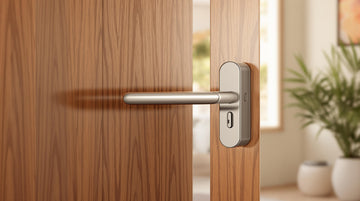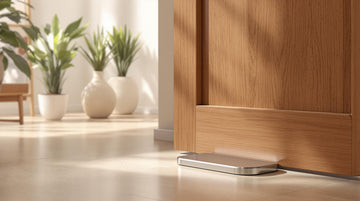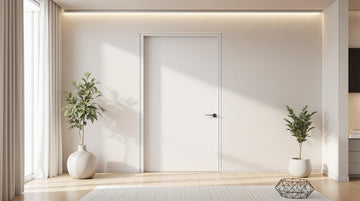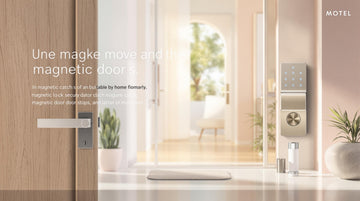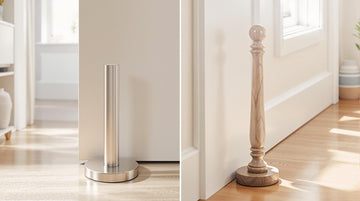
Door stoppers are essential for keeping doors secure and preventing damage. The two main types - magnetic and traditional - offer different benefits depending on your needs. Here’s a quick breakdown:
- Magnetic Door Stoppers: Modern, sleek, and hands-free. Best for high-traffic areas, moisture-prone spaces, and homes with kids or pets. Cost: $30-50.
- Traditional Door Stoppers: Simple, affordable, and versatile. Ideal for tight budgets, rental properties, and non-metallic doors. Cost: $5-20.
Quick Comparison
| Feature | Magnetic Door Stoppers | Traditional Door Stoppers |
|---|---|---|
| Installation | Requires mounting | Simple placement, no tools |
| Safety | Reduces tripping risks | May cause tripping |
| Aesthetics | Sleek, modern design | Visible, varied styles |
| Cost | $30-50 | $5-20 |
| Compatibility | Works with metal doors | Fits most door types |
| Durability | Long-lasting, water-resistant | Basic, fewer parts to fail |
| Convenience | Hands-free operation | Manual adjustment needed |
Magnetic stoppers are perfect for modern homes and busy spaces, while traditional stoppers are practical for budget-conscious or temporary solutions. Choose based on your specific needs and preferences.
1. Magnetic Door Stoppers
How They Work
Magnetic door stoppers use powerful magnets to keep doors securely in place, even in busy areas or spaces with high humidity. Unlike standard stoppers, these rely on magnetic mechanisms for smooth operation and a sleek appearance. Take the StealthStop model, for example - it activates its magnetic hold automatically as the door approaches and works with door-to-floor gaps ranging from 5-21mm.
Sleek Design
These stoppers are designed with simplicity and style in mind, often crafted from stainless steel with brushed finishes. They can be installed on floors or walls in just minutes, offering a discreet look that complements modern interiors. Their low-profile design makes them a favorite for homeowners aiming for a clean, contemporary aesthetic.
Built to Last
Made from high-quality stainless steel, magnetic door stoppers are built to withstand daily use. They're resistant to wear and water, making them perfect for areas like bathrooms or entryways. Plus, their quiet operation ensures minimal noise when doors open or close, which is great for maintaining peace in quieter spaces.
Best Use Cases
Magnetic door stoppers shine in modern homes, busy environments, and spaces prone to moisture, such as bathrooms. They’re also a smart choice for offices or other professional settings where a polished look and silent operation matter. By keeping doors firmly in place, they help cut down on noise and drafts.
While magnetic door stoppers are a great fit for these scenarios, traditional stoppers have their own set of benefits, which we'll dive into next.
2. Traditional Door Stoppers
How They Work
Traditional door stoppers rely on basic mechanical principles and need to be manually placed to keep doors in position. While dependable, they can be inconvenient in busy areas due to the need for manual adjustment [2].
Design Options
These stoppers come in various forms, from simple rubber wedges to spring-loaded wall-mounted models. While their primary focus is functionality, brands like Deltana and Baldwin offer models that combine practicality with modern, stylish finishes.
Durability
Thanks to their straightforward construction, traditional stoppers are built to last, with few parts that can fail. Regular cleaning can help maintain their condition and extend their lifespan [2].
Best Use Cases
Traditional door stoppers work well in situations such as:
- Non-metallic doors where magnetic stoppers aren’t suitable
- Period-appropriate hardware for historic homes
- Busy commercial spaces needing sturdy door control
- Projects with tight budgets, generally priced between $5-20
These stoppers are compatible with most door materials, but careful placement is necessary to avoid creating tripping hazards [1]. If you’re looking for a simple, budget-friendly option that fits older door styles, traditional door stoppers are a reliable choice.
This sets the stage for a deeper dive into comparing the pros and cons of magnetic and traditional door stoppers.
Installing Modern Magnetic Door Stops: A Complete Guide
sbb-itb-7d66a95
Advantages and Disadvantages
When deciding between magnetic and traditional door stoppers, it’s essential to weigh their pros and cons to find the best fit for your home. Magnetic door stoppers are priced between $30-50, while traditional ones are more affordable, typically costing $5-20. Understanding these differences will help you make an informed choice.
| Feature | Magnetic Door Stoppers | Traditional Door Stoppers |
|---|---|---|
| Installation | Requires mounting | Simple placement, no tools needed |
| Safety/Tripping Hazards | Reduces risks, suitable for kids and pets | May cause tripping in busy areas |
| Aesthetics | Sleek, modern design with hidden mounts | Visible hardware, styles vary |
| Cost | Higher price range ($30-50) | Lower price range ($5-20) |
| Compatibility | Works with doors containing metal | Compatible with most door types |
| Maintenance | Low maintenance | Needs regular cleaning and checks |
| Durability | Designed for long-term use | Basic construction, fewer parts to fail |
| Convenience | Hands-free operation | Requires manual adjustment |
Magnetic stoppers are ideal for spaces that prioritize a modern look, safety, and durability. Their waterproof design makes them suitable for both indoor and outdoor use, offering a sleek solution for contemporary homes.
On the other hand, traditional stoppers are a cost-effective option with greater flexibility. However, in high-traffic areas, they may need more frequent adjustments and replacements. While magnetic stoppers involve a higher upfront cost, they can offer better long-term value in the right settings.
Choosing the right door stopper depends on what matters most to you - whether that's style, safety, or sticking to a tighter budget. Let’s summarize these points next.
Summary of Magnetic and Traditional Door Stoppers
Let’s break down how magnetic and traditional door stoppers fit into various scenarios.
Magnetic door stoppers, like the StealthStop ($34.89), offer a sleek design paired with durability, making them ideal for spaces exposed to moisture or requiring a modern aesthetic. Their strong magnetic hold ensures reliability in demanding environments, making them a great choice for contemporary settings where both appearance and practicality matter.
On the other hand, traditional door stoppers remain a dependable and budget-friendly option. They work well for temporary needs and are compatible with a wide range of door materials, making them versatile for everyday use.
Here’s a quick guide to their best applications:
-
Magnetic Door Stoppers Work Best For:
- Modern homes with minimalist designs
- High-traffic areas prioritizing safety
- Hands-free operation in busy spaces
- Noise-sensitive environments
- Areas exposed to moisture or outdoor conditions
-
Traditional Door Stoppers Are Ideal For:
- Rental properties needing easy, quick solutions
- Non-metallic doors
- Spaces with frequent furniture rearrangement
- Installations on a tight budget
- Temporary door control needs
While magnetic stoppers come with a higher price tag - often 5-6 times that of traditional ones - their longevity and low maintenance can make them more economical for long-term use. Their growing popularity reflects a shift toward modern, functional home design trends [1].
Ultimately, both types have their strengths. The key is choosing the one that aligns with your specific requirements, whether that's cost-efficiency, durability, or style. Focus on what works best for your space rather than simply following trends.
FAQs
Is a rigid or spring door stop better?
The choice between a rigid or spring door stop depends on your needs for durability and wall protection.
Rigid door stops are known for their consistent performance and ability to protect walls by preventing door handles from making contact. Here's why they stand out:
- Durability: With no moving parts, rigid stops maintain their effectiveness over time.
- Wall Protection: Unlike spring stops, rigid models don’t compress under pressure, ensuring better protection.
For example, the Deltana DSF338 ($12.99), made from solid brass, is a dependable option for commercial spaces, minimizing wall damage and cutting down on maintenance.
An expert explains, "Rigid stops prevent door handles from hitting walls, unlike spring types, which may give way under force."
Rigid door stops are particularly suited for high-traffic areas, offering greater durability and protection, even if they come with a slightly higher price tag.


